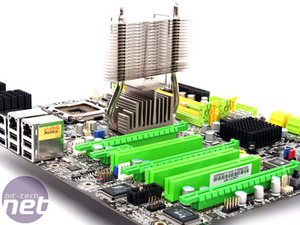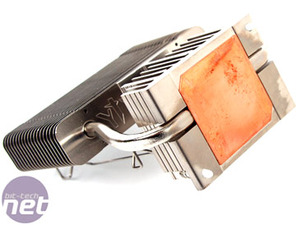Board Layout
As usual DFI makes a great looking motherboard – the colour and design is virtually unmatched, still, and despite the "strange" choice of yellow and green, it really does work well aesthetically. Of course, all of the slots and connectors are UV reactive, meaning they’ll glow if you’ve filled your case with black lights – further adding to the appeal.Before we go any further let’s talk about the north bridge heatsink: it’s a behemoth. While clearly super sized, it’s actually ideal for the application though. First of all the base heatsink isn’t too tall, meaning that there shouldn’t be a problem when it comes to installing larger CPU coolers. Secondly, the fins and heatpipes are off centre so they can be orientated closer to the CPU space or nearer the PCI-Express slot.
Why its genius doubles up is because there are no heatpipes used at all – this means you can individually dump the north bridge, south bridge or PWM heatsink and swap each out for your favourite alternative should you wish: want to watercool the PWMs on their own? No problem.
The copper core is nice and flat, and actually clean when you first get it, but the tiny syringe of thermal paste gives you all of two applications. In addition, the two push-pins just aren’t as secure as screws, especially with the heatsink’s high centre of gravity.
The PWM cooler that DFI is so fond of might be nice and big, but it doesn’t cool the digital chokes as well as the hot little PWMs. We were talking to a thermal expert at a popular heatsink company when he pointed this out. He voiced concern about the heat the chokes generate, but because they are so close to the CPU area he could also understand why they aren’t cooled – even though it isn't an impossible task to cool them.
We contacted DFI for a comment and were told that the chokes can resist temperatures up to 160˚C so there was no need to worry, and touching them during testing they didn't feel that hot either.


Eight SATA sit at the edge of the board so they don’t conflict with any long cards plugged in. The placement is good, but they don't feature the little clips to secure the cables when they’re plugged in.
DFI has done the right thing in relegating the floppy port to the bottom of the board and leaving the IDE slot up by the memory and ATX connector. Unfortunately DFI has used the JMicron JMB363 controller for the IDE which isn’t that great. Some have reported problems with DVD-RW performance and when we used this chipset with ACHI enabled in Vista, one of our eSATA drives (on another board) had serious problems with the system locking up or ignoring the drive completely. This board doesn’t feature eSATA though and there are no PCI bracket adapters like the ones that Gigabyte offers either.

MSI MPG Velox 100R Chassis Review
October 14 2021 | 15:04











Want to comment? Please log in.